By recording hundreds of bands across a wide spectral bandpass, hyperspectral imaging enables the identification of specific crop characteristics based on their chemical composition.
Minna Törmälä, Specim, Spectral Imaging Ltd.; And Vittorio Calbucci, IMAGE S SPA
Vertical farming, also known as sky farming, is the practice of growing food crops in vertically stacked layers in controlled indoor spaces using soilless hydroponic or aeroponic growing methods. Vertical farming does not replace conventional farming or greenhouse production, but it can provide a significant niche for food production, especially for large cities. It does so by relying on technology to monitor various parameters and to minimize energy consumption, water usage, fertilizers, and pesticides.
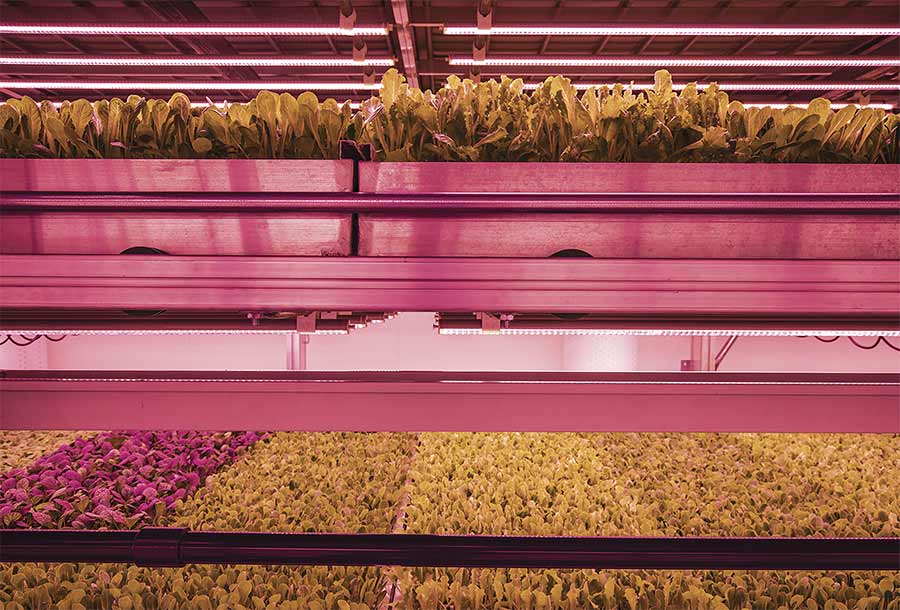
LED systems provide controlled lighting all year round for data-driven businesses. Courtesy of Agricola Moderna.
By taking advantage of unused spaces such as abandoned buildings and containers in cities, vertical farming enables the production of food in urban or semiurban locations where arable land is unavailable. The method’s
advantages include proximity to
consumers and year-round availability.
The vertical farming market has rapidly grown over the last decade. Key drivers of market growth include urbanization and an increase in global demand for food. The market size of global vertical farming was valued at nearly $3.1 billion in 2021 and is expected to grow at a compound annual growth rate of 23.5% between 2020 and 20301.
Data-driven business
The main advantage of vertical
farming is the ability to increase crop yields while using less space. Sensors, and the data they provide, play a pivotal
role in successful vertical farming by continuously measuring plants’ health and ensuring optimal growth conditions. Early detection of plant diseases and insect infestation is crucial for
vertical and traditional farmers to be able to maximize yields and reduce economic loss.
Current applications of vertical farming, coupled with state-of-the-art technologies such as hyperspectral imaging, have resulted in 100× higher crop yields than traditional farming, while using 98% less soil and 95% less water.
Standard vision systems that use filters, RGB and thermal cameras, and light intensity sensors were the first imaging technology solutions to be adapted for comprehensive vegetation inspection and analysis. Multispectral and hyperspectral imaging, however, provide advantages over standard
vision systems and are currently the two most-used technologies in precision and vertical farming.
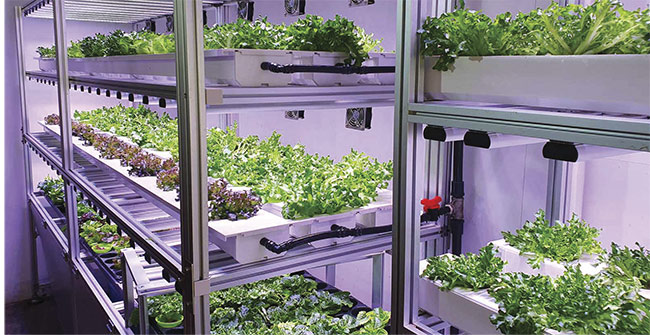
Leafy greens grow inside a vertical farm. Courtesy of Agricola Moderna.
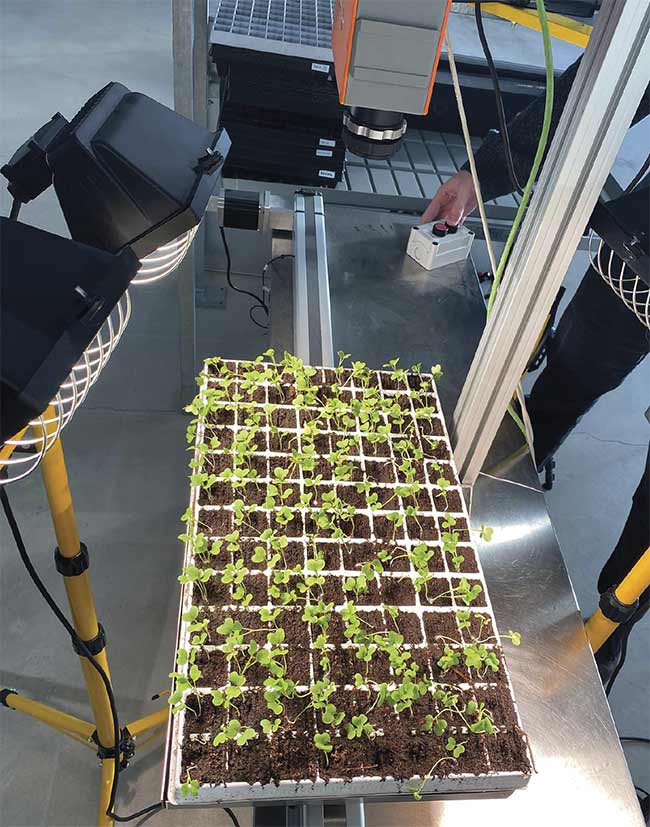
Crops are scanned using a Specim FX10 VNIR hyperspectral camera. Courtesy of Agricola Moderna.
Spectral data enables the analysis of the phenotypic characteristics of plants. Multispectral and hyperspectral imaging are used to monitor plant diseases, insect pests, and invasive plant species, and to estimate crop yield and classify crop distributions.
Revealing the invisible
Hyperspectral imaging combines the advantages of conventional spectroscopy and imaging techniques, providing valuable information for vertical farming. It is particularly well suited for performing spectral analysis of crops based on the light they reflect.
The spectral data enables further analysis of the phenotypic characteristics of crops and allows extraction of information that would otherwise be lost.
By recording hundreds of bands across a wide spectral bandpass, hyperspectral imaging can identify specific crop characteristics based on their chemical composition, rather than on visible characteristics such as size, shape, or color.
Near-infrared (NIR) hyperspectral cameras, which cover the 900- to 1700-nm wavelength range, are typically used in precision agriculture for crop analysis. Healthy organic material reflects more IR light than unhealthy, dead, or inorganic material. NIR spectroscopy detects moisture, fat, starch, and protein in crops, allowing growers to take quick corrective action to enhance the quality and quantity of produce.
Hyperspectral imaging systems simultaneously acquire images in many narrow, contiguous spectral bands
and can monitor even small changes in the chemistry of plants. Compared to multispectral cameras, hyperspectral cameras capture more narrow bands in the same portion of the electromagnetic spectrum. Whereas multispectral imaging generally uses three to 10 bands, hyperspectral imaging uses hundreds to thousands of narrow (about 10- to 20-nm) bands.
For example, determining the levels of macroelements — such as nitrogen,
phosphorus, and potassium — and the quantities of anthocyanins (which belong to the flavonoid family) is important for understanding plants’ health. This information cannot be captured using traditional RGB cameras. Multispectral cameras can measure some general characteristics that indicate plant health, but hyperspectral imaging provides the more detailed information that is needed to diagnose plant disease.
Chemical analysis is the traditional method for assessing crop health, but
the method is both time-consuming and expensive. By contrast, hyperspectral imaging is rapid, precise, and nondestructive. Data can be acquired using a stationary optical setup mounted above or beside vegetation, or by placing the acquisition system on a robotic arm that scans the plants directly at the point of cultivation.
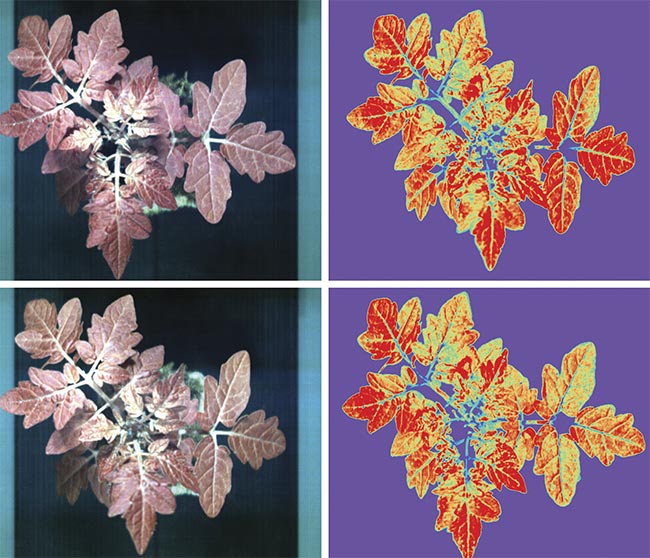
An assessment of the normalized difference vegetation index (NDVI) using an RGB camera (left) versus a Specim FX10 hyperspectral camera
(right). Courtesy of Specim, Spectral Imaging Ltd.
In addition to vertical farming, hyperspectral imaging is also used for field experiment sampling — for example, in near-Earth remote sensing applications, in which cameras are mounted on rovers or unmanned aerial vehicles. Samples are extracted and analyzed in the laboratory.
Vegetation indices
Agricultural applications also benefit from the use of vegetation indices, which depict and quickly map plant health by mathematically manipulating
hyperspectral data. The indices are used to reliably assess a variety of information about the health of crops; monitor nutrition values; optimize the use of fertilizers, energy, and water;
and predict the harvesting season and yield.
The normalized difference vegetation index (NDVI) and the soil-adjusted vegetation index (SAVI), for example, use hyperspectral data to estimate the leaf area index (LAI). The plant senescence reflectance index (PSRI) uses hyperspectral data to monitor vegetation health, plant stress, crop production, and yield analysis. The NDVI also provides information on crop growth and nutrients, which can be used to predict a crop’s nitrogen demand, for example, and to guide the intelligent application of nitrogen fertilizer.
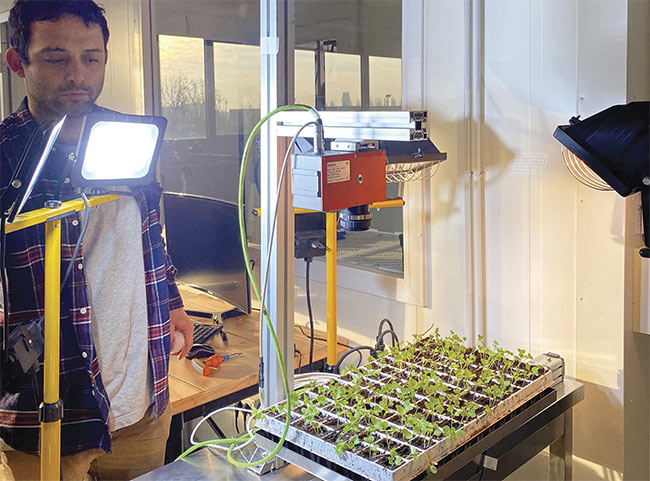
Duccio Piovani, head of data science and AI at Milan-based Agricola Moderna, in the company’s lab. Courtesy of Agricola Moderna.
The various vegetation indices are simple algebraic combinations of the reflectance values at specific frequencies, which change based on the application. The most useful wavelength ranges for plant and vegetation analysis are the visible and near-infrared (VNIR) portion of the electromagnetic spectrum — the visible range of 400 to
700 nm and the NIR range of 700 to 1300 nm.
VNIR hyperspectral cameras, such as the Specim FX10, for example, can operate in the 400- to 700-nm wavelength range and can accurately capture changes in leaf pigmentation, specifically chlorophyll absorption and concentration — often referred to as the “red edge,” in reference to the rapid change in the reflectance of vegetation in the NIR range.
Studying leaves’ mesophyll cell structure requires a hyperspectral imaging system with a NIR wavelength range. This spectral range is used for calculating the NDVI index, for example. Detecting changes in a plant’s water content requires shortwave infrared (SWIR) cameras with a 1300- to 2500-nm wavelength range.
The future of vertical farming
To achieve continuous and detailed
plant monitoring, growers must combine data from a large number of optical and other technologies, which requires sensor and data fusion. One grower that is using such an approach is Milan-based Agricola Moderna, a 1500-sq-m vertical farm that produces and sells leafy greens for salads to supermarkets and restaurants in the region. The company is at the forefront of efforts toward fully automized and AI-driven vertical farming. Its platform uses several types of sensors, such
as RGB-D cameras for canopy 3D
reconstruction and various environmental sensors that measure temperature, light intensity, and CO2 levels. The company uses hyperspectral imaging to monitor plants’ nitrogen, phosphorus, and potassium levels. The information obtained is sent to a central database to be analyzed.
When Agricola Moderna scans crops, it captures several gigabytes of hyperspectral data. The company develops algorithms in-house to manipulate and analyze the data. This analysis can be used to detect whether plants are healthy or sick. The hyperspectral data enables the company to speed up the analysis of plants and take corrective actions to optimize yield growth. The grower has also managed to
quantify some plant species’ color brightness, which provides valuable information about the company’s products.
In collaboration with the computer science department at Sapienza
University of Rome and the biology department at the University of Milan, Agricola Moderna is continuously
exploring new opportunities to adapt the latest advancements in deep learning and other data science techniques to vertical farming.
“We believe we have only started scratching the surface of an up-and-coming field,” said Duccio Piovani, head of data science and AI at the company. “The field is at the crossroads of many different disciplines — such as biology, hyperspectral
imaging, computer vision, and artificial
intelligence — which are already
playing a central role in growing crops. Hyperspectral imaging provides
valuable information, little to none of which could be gleaned from RGB cameras, that is essential for vertical
farming. Precision agriculture is a technique that can highly benefit from hyperspectral sensing, and the role of hyperspectral data in vertical farming and agriculture, in general, is destined to grow.”
Reference
1. Emergen Research (June 2022). Vertical farming market, by system (hydroponics, aeroponics, aqua-
ponics), by type (aggregate system, liquid system) by structure (building-based, shipping container-based),
by equipment, and by region forecast to 2030.
Meet the authors
Minna Törmälä is global marketing manager at Specim, Spectral Imaging Ltd. She holds a doctorate in marketing
from Oulu Business School and
specializes in value creation for new technology ventures; email: [email protected].
Vittorio Calbucci, Ph.D., is a member of the technical department of iMAGE S Group. He holds a physics degree
from Università of Milan (la Statale)
and a doctorate in physics from
Università Politecnica delle Marche
in Italy. He specializes in materials characterization by nondestructive techniques and spectroscopy methods; [email protected].